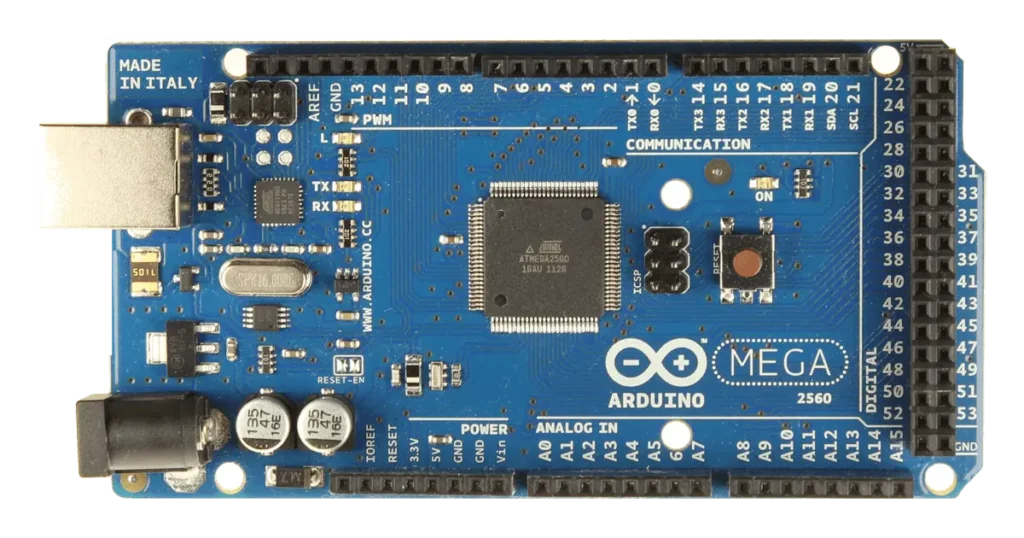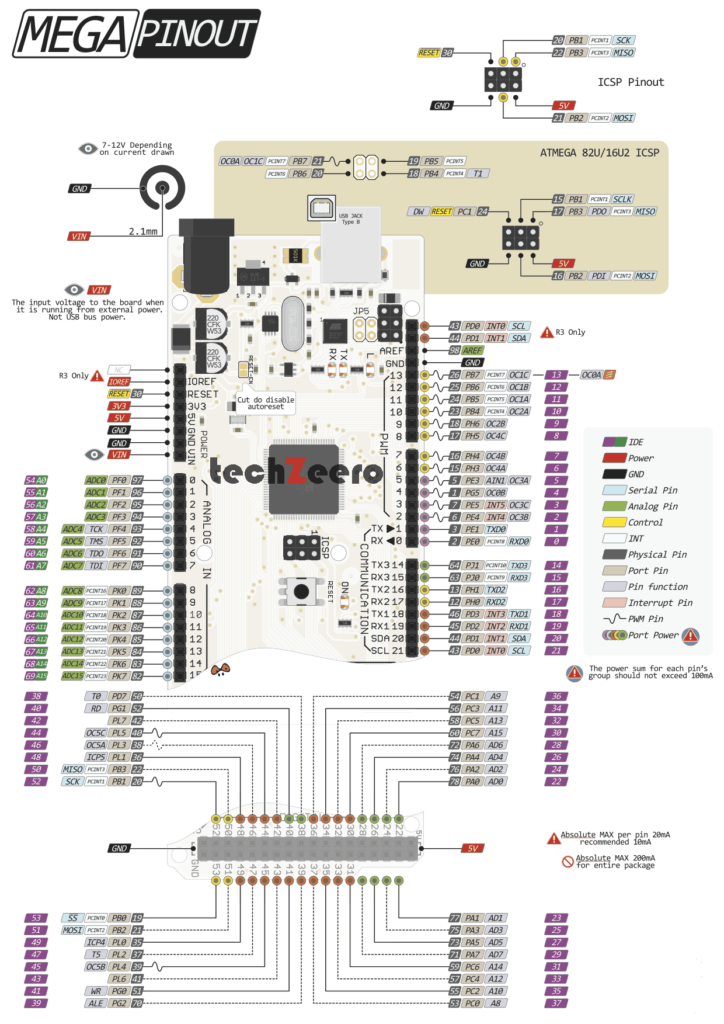What is an Arduino Mega?
The Arduino Mega is a powerful microcontroller board based on the ATmega2560 chip, offering an upgraded version of the classic Arduino Uno. With its increased memory and more pins, the Arduino Mega provides enhanced capabilities for complex projects in robotics, automation, and IoT.
Equipped with 54 digital I/O pins (of which 15 can be used as PWM outputs) and 16 analog inputs, the Arduino Mega offers ample options for connecting sensors, motors, displays, and other components. Its versatility makes it a popular choice among advanced users who require a larger number of connections for their projects.
In addition to its hardware features, the Arduino Mega is compatible with the Arduino software IDE, allowing users to easily write and upload code to control their devices.

Arduino Mega Pinout
The Arduino Mega is a powerful microcontroller board that offers an impressive array of features and capabilities. It comes equipped with 54 digital I/O pins, 16 analog inputs, and a larger memory size compared to other Arduino boards. This makes it ideal for complex projects that require a high number of input/output connections.
In terms of specifications, the Arduino Mega runs at 16 MHz clock speed and has 256 KB of flash memory for storing your code. Additionally, it boasts 8 KB of SRAM and 4 KB of EEPROM for data storage.
The pinout layout on this board is designed to provide easy access to its various functionalities. Pins are grouped into categories like power pins, communication pins (UART, SPI, I2C), PWM pins for controlling motors or LEDs, and more. This organized layout simplifies connecting external components to the board for seamless integration into your projects.

Technical Specifications
n terms of specifications, the Arduino Mega based on ATmega2560 which runs at 16 MHz clock speed and has 256 KB of flash memory. It is operated on 5V of voltage. It comes with length of 101.52 mm, 53.3 mm width and approx 37gm of weight. These specs make this board well-suited for handling demanding tasks such as robotics, automation, and data logging applications.
| Microcontroller | ATmega2560 |
| Operating Voltage | 5V |
| Digital I/O Pins | 54 (of which 15 provide PWM output) |
| Analog Input Pins | 16 |
| DC Current per I/O Pin | 20 mA |
| DC Current for 3.3V Pin | 50 mA |
| Flash Memory | 256 KB of which 8 KB used by bootloader |
| SRAM | 8 KB (ATmega2560) |
| EEPROM | 4 KB |
| Clock Speed | 16 MHz |
| LED_BUILTIN | 13 |
| Length | 101.52 mm |
| Width | 53.3 mm |
| Weight | 37 g |
Programming with the Arduino Mega
When it comes to programming with the Arduino Mega, the possibilities are endless. The board is compatible with the Arduino IDE, making it easy for both beginners and advanced users to write code. You can create custom functions, control sensors and actuators, or even develop complex projects using this powerful microcontroller.
One of the key features of the Arduino Mega is its abundant I/O pins, allowing you to connect a wide range of components without running out of available ports. Whether you’re working on robotics, automation systems, or IoT devices, the Mega offers ample resources for your coding needs.
With a simple USB connection, you can upload your sketches directly to the board and test them in real-time.
Pros and Cons of using Arduino Mega
When it comes to using the Arduino Mega, there are several advantages that make it a popular choice among makers and electronics enthusiasts.
One of the main pros is its extensive range of digital and analog pins, providing ample room for connecting sensors, actuators, and other components for complex projects. Additionally, the Mega offers more memory and processing power compared to other Arduino boards, making it suitable for larger-scale applications.
On the flip side, one potential drawback of this board is its size. Due to its large form factor, it may not be ideal for compact or space-constrained projects. Moreover, beginners might find the multitude of pins overwhelming at first glance, requiring some time to grasp their functionality fully.